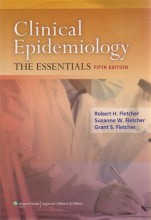Summary: Clinical Epidemiology | Diederick E Grobbee, et al
- This + 400k other summaries
- A unique study and practice tool
- Never study anything twice again
- Get the grades you hope for
- 100% sure, 100% understanding
Read the summary and the most important questions on Clinical Epidemiology | Diederick E. Grobbee; Professor of Clinical Epidemiology Julius Center for Health Sciences and Primary Care University Medical Center Utrecht Utrecht Netherlands Diederick E Grobbee; Arno W. Hoes
-
2 diagnostic research
This is a preview. There are 19 more flashcards available for chapter 2
Show more cards here -
What is the 'threshold probability' ?
High or low probability for presence or absence of the disease, guiding clinical decisions. These are determined by the consequence of a false-positive of false-negative diagnosis. These thresholds vary between doctors. -
What is the term diagnosis mean?
It's a compound of dia (apart/ distinction) and gnosis (knowledge). Together diagnosis is defined as: the art of distinguishing one disease from the other. -
What is a prior probability and a posterior probability?
The probability of the presence of the target disease before a test is performed. (introduced by Thomas Bayes).
The changed prior probability taking into account the testresults. -
What is Bayes rule?
A mathematical rule to quantify the posterior probability based on the prior prob and the diagnostic accuracy estimates.
Diagnostic accuracy estimates are: sensitivity, specificity or likelihood ratio of a test.
Assumption regard this rule: the estimates are constant, which in reality are not. -
What is the goal of diagnostic research?
To predict the presence of the yet unknown underlying disease.
In diagnostic research do not play a role in the occurence relation. Other determinants often are additional diagnostic testresults. Diagnostic research should be performed in close adherence of daily practice to ensure its applicability. -
What is a test research?
Onediagnostic test is examined in two groups; with the target disease and a group with nodisease . It allows calculation of 4 measures ofdiagnostic accuracy. -
What is the difference in occurence relation between test research and diagnostic research?
test research: e.g. P (D) = f (T)
one test: Prob of presence of disease given a certain testresult or prob of testresult given the disease (or not).
diagnostic research: P (D) = f (T1, T2, T3, .....Tn)
multiple tests: prob of presence of disease given multiple testresults. -
What determines the size of studyopulation?
There is no power calculation for multivariable prediction models.
Rule of tumb is that there are at least 10 subject are neede for each determinant. -
What is a univariable analysis?
Also described as bivariate analysis (the relatio between a determinant and the outcome)
the goal is to obtain insight in the association between a potential determinant and the presence of absence of the outcome.
Often with dichotomous or dichotomized measures. Which gives loss of information and the applied threshold should be explained. -
When should a derterminant be included in the multivariable analysys?
- when the univariable analysis shows statistical significance -> can lead to optimistic estimates
- use a higher threshold (p>0.20) -> when more determinants are incorporated, than penalization or shirinkage methods are required.
- Higher grades + faster learning
- Never study anything twice
- 100% sure, 100% understanding
































